
Table of contents
Table of contents
Organizational planning: The complete guide for 2026

What you'll learn in this article
The organizational planning challenge: Only 45% of organizations met their 2024 strategic goals, with 67% of functions misaligned with corporate strategy — despite massive increases in collaboration.
In this guide, you'll discover:
- The 4 types of organizational planning every successful company uses (strategic, tactical, operational, contingency) and when to apply each
- A proven 7-step process from vision to execution — used by companies like PepsiCo to cut time-to-market from 3 years to 10 months
- 6 essential frameworks (SWOT, OKRs, Balanced Scorecard, Porter's Five Forces, McKinsey 7S, Ansoff Matrix) with decision guides on when to use each
- 5 critical planning challenges causing 90% of strategies to fail — and practical solutions including visual collaboration and agile planning methodologies
- How to choose planning tools that bridge strategy and execution, with comparison frameworks for visual planning vs. task management
- 8 best practices for 2025 including quarterly reviews (making organizations 43% more adaptive), AI automation, and feedback loops
The bottom line: Successful organizational planning isn't an annual event — it's a continuous process powered by visual collaboration, proven frameworks, and tools that connect daily work to company vision.
Time to read: 12 minutes
Only 45% of organizations report meeting several of their 2024 strategic goals, according to recent Gartner research — despite teams collaborating 50% more than they did just a decade ago. The culprit? A disconnect between strategic vision and daily execution, amplified by collaborative overload and misalignment across departments.
As we enter 2026, successful organizational planning requires more than annual goal-setting sessions. It demands visual collaboration, agile frameworks, and tools that bridge the gap between strategy rooms and execution teams. This guide shows the complete organizational planning process used by leading companies, including PepsiCo, which reduced time-to-market from 3 years to 10 months using visual planning methodologies with Miro.
You'll learn the 7-step organizational planning process, essential frameworks, practical tools for organizational structure planning, and how to avoid the pitfalls that during organizational strategic planning.
Understanding organizational planning
Organizational planning is the systematic process of defining a company's vision, setting strategic goals, and mapping the tactical steps needed to achieve them — while aligning organizational structure, resources, and daily work to support execution.
Why does this matter? Because goals mean nothing if your organization doesn't have the right structure, skills, and capacity to take action on them. The gap most companies face isn't about setting ambitious targets — it's about connecting those targets to the work teams do every day.
What effective organizational planning achieves:
- Alignment across departments, eliminating silos and conflicting priorities
- Clarity on who does what, when, and why it matters to company success
- Agility to adapt when markets shift or new opportunities emerge
- Measurable results tied directly to strategic objectives
The 4 types of organizational planning
Understanding which type of organizational planning you need helps you scope the right process and involve the right stakeholders.
1. Strategic Planning (3-5 years)
Long-term vision, mission, and major objectives typically led by C-suite and board members. This sets the direction for everything else.
Example: "Become the market leader in sustainable manufacturing by 2028"
2. Tactical Planning (1-2 years)
Translates strategy into department goals, quarterly OKRs, and annual initiatives. This is where strategy meets operational reality.
Example: "Launch 3 eco-friendly product lines in 2025"
3. Operational Planning (Weeks/Months)
Day-to-day tasks and workflows at the team level. This is the execution layer where work actually gets done.
Example: "Complete Q1 product testing by February 15"
4. Contingency Planning (Ongoing)
Risk mitigation and backup plans for potential disruptions. Often overlooked until it's too late.
Example: "Maintain 3-month supply chain buffer for critical components"
Organizations using all 4 planning types create stronger alignment across the organization. According to Gartner research, 67% of key functions are not aligned with business unit and corporate strategies — a critical gap that comprehensive planning across all levels helps address.
How to create an organizational plan: The 7-step process
Based on analysis of successful organizations, this 7-step framework connects vision to execution while maintaining flexibility for change.
Step 1: Define vision, mission & values
Start with the foundation. Your vision is the inspirational 10-year destination, your mission explains your core purpose and stakeholder value, and your values guide decision-making when the path isn't clear.
Use collaborative workshops to build consensus. "Being able to bring everyone together to plan in Miro ultimately means that the most impactful initiatives will happen at the right time," notes Lucy Starling, Product Operations Lead at ASOS, who streamlined their planning process.
Template approach: Gather cross-functional leaders to work on your Miro workspace where everyone can contribute simultaneously, vote on priorities, and see the thinking process unfold in real-time.
Step 2: Conduct current state assessment
Before you can chart a path forward, you need to understand where you stand today.
Internal analysis: Review your resources, capabilities, and organizational structure. What skills do you have? What's missing? Where are the bottlenecks?
External analysis: Examine market trends, competitive landscape, and emerging opportunities or threats.
SWOT Analysis framework: This classic tool maps your Strengths and Weaknesses (internal) against Opportunities and Threats (external) to reveal strategic options.
Critical finding: 60% of executives admit they didn't spend sufficient time assessing organizational state before redesigning, according to McKinsey's research on organizational transformation.
To keep all teams aligned, it's important to settle on a system or artifact for tracking and reporting. This ensures transparency and traceability as you all go about reaching your strategic vision.
Step 3: Set strategic goals
Now translate your vision into 3-5 major strategic priorities using the SMART framework: Specific, Measurable, Achievable, Relevant, and Time-bound.
Goal structure example:
- Strategic Goal: Become customer-obsessed organization by Q4 2025
- Metric 1: Achieve Net Promoter Score of 70+
- Metric 2: Reduce customer churn to below 5%
- Metric 3: Maintain 95% response rate under 24 hours
Goals should cascade from company level → department level → team level, creating clear line-of-sight between individual work and organizational success.
Step 4: Develop tactical plans
Break strategic goals into quarterly and annual initiatives with clear ownership. This is where the "what" becomes the "how."
Key elements:
- Specific initiatives tied to each strategic goal
- RACI assignments (Responsible, Accountable, Consulted, Informed)
- Resource allocation and budget planning
- Visual roadmaps showing dependencies
"With Miro, we went from project brief to in-market launch in 10 months. That usually takes 3 years at PepsiCo," shares a PepsiCo product team on how visual planning accelerated their go-to-market process.
Create visual roadmaps that show how initiatives connect, which teams own what, and where dependencies exist between workstreams.
Step 5: Align organizational structure
Your organizational structure should support your strategic priorities, not work against them.
Key steps:
- Map your current org structure with our org chart maker
- Identify skill gaps and hiring needs
- Align teams to strategic priorities
- Redesign structure if needed to support goals
When you design (or redesign) your org chart with your strategic priorities as your compass, you go beyond determining what needs to happen and take the extra step to figure out who's going to do it.
Visual organizational planning using Miro makes it easier to spot gaps, test different structures, and communicate changes across the organization. Learn how to create an org chart that aligns with your strategic objectives, or explore org chart examples to see how different organizational structures work in practice.
Watch: See how teams use visual planning to align organizational structure with strategy in this step-by-step demonstration.
Step 6: Allocate resources & budget
Map your resources — people, technology, and capital — to initiatives based on strategic importance.
Prioritization framework: Use an impact vs. effort matrix to identify quick wins and strategic bets. Avoid the common mistake of spreading resources too thin across too many priorities.
Timeline planning: Set realistic milestones with built-in buffers for unexpected challenges.
Risk assessment: Identify what could go wrong and create contingency budgets accordingly.
Step 7: Monitor, measure & adapt
The plan is just the beginning. Success requires ongoing monitoring and willingness to adapt.
Establish review cadences:
- Weekly: Team progress check-ins on tactical work
- Monthly: Initiative status updates and blocker resolution
- Quarterly: Strategic goal reviews with adjustment authority
Build feedback loops for continuous improvement. The product strategy story is dynamic. It evolves as the team progresses and its context changes.
When to pivot vs. persevere: Set clear criteria in advance for what signals would trigger a strategic shift versus temporary setbacks that require persistence.
Organizations that review plans quarterly are 43% more adaptive to market changes, according to research on strategic agility.
6 Organizational planning frameworks you need to know
Frameworks provide structure for strategic thinking. Here are the 6 most effective models for 2026, when to use each, and how to visualize them effectively.
Framework 1: SWOT Analysis
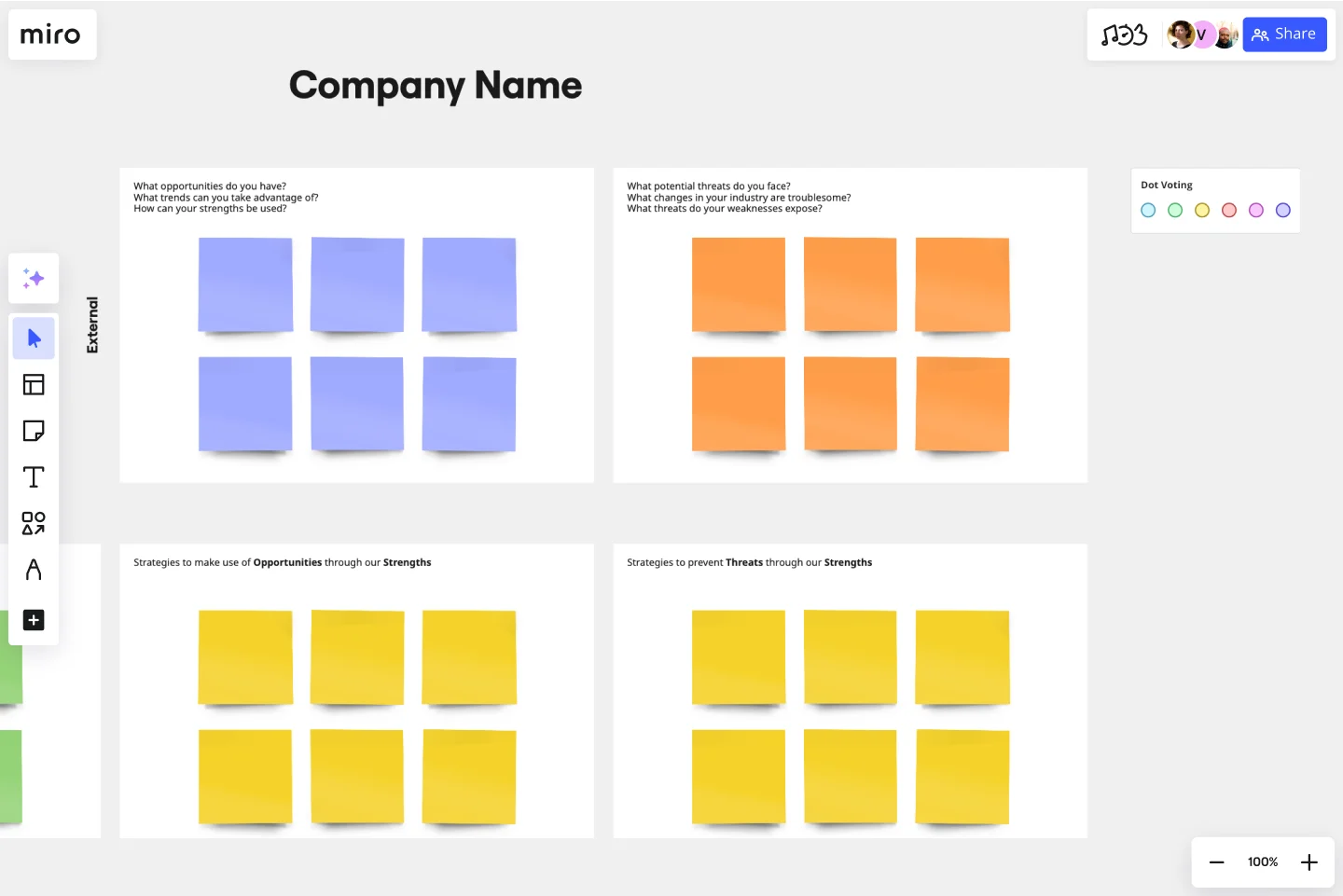
Structure: Strengths, Weaknesses (internal) + Opportunities, Threats (external)
Best for: Current state assessment and strategic positioning at the start of your planning process
How to run: Facilitate a cross-functional workshop where teams use sticky notes to populate each quadrant. Group similar themes and identify patterns.
Visualization: Use a 2x2 matrix on an infinite canvas where teams can add context, vote on priorities, and link insights to specific strategic initiatives.
Framework 2: OKRs (Objectives & Key Results)
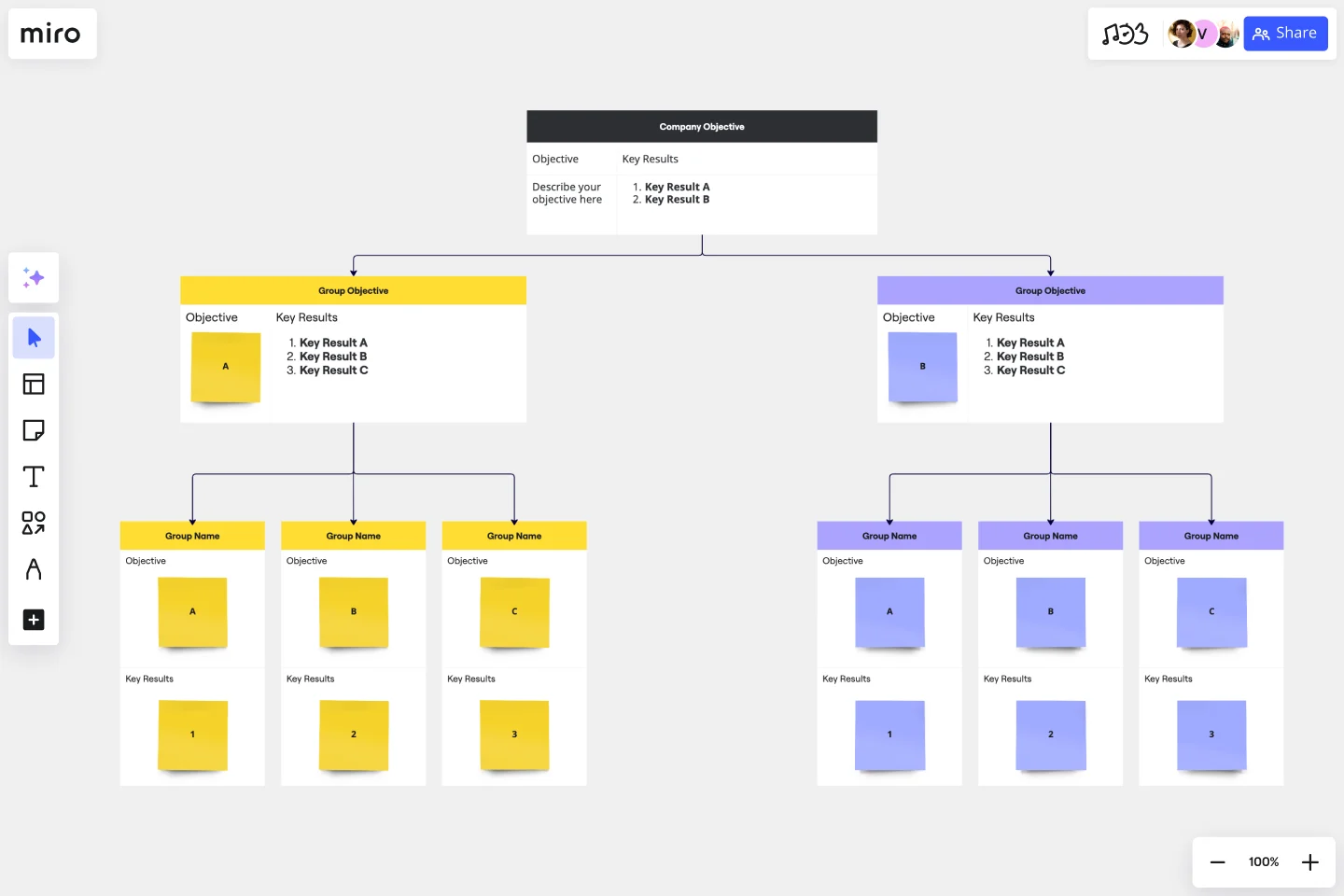
Structure: 1 qualitative Objective + 3-5 measurable Key Results
Best for: Goal cascading, quarterly planning, and progress tracking across the organization
Scoring: Use a 0-1.0 scale where 0.7 = success (encourages ambitious goal-setting)
Example:
- Objective: Become customer-obsessed organization
- KR1: Achieve NPS of 70+
- KR2: Reduce churn to <5%
- KR3: 95% response rate <24hrs
Framework 3: Balanced scorecard
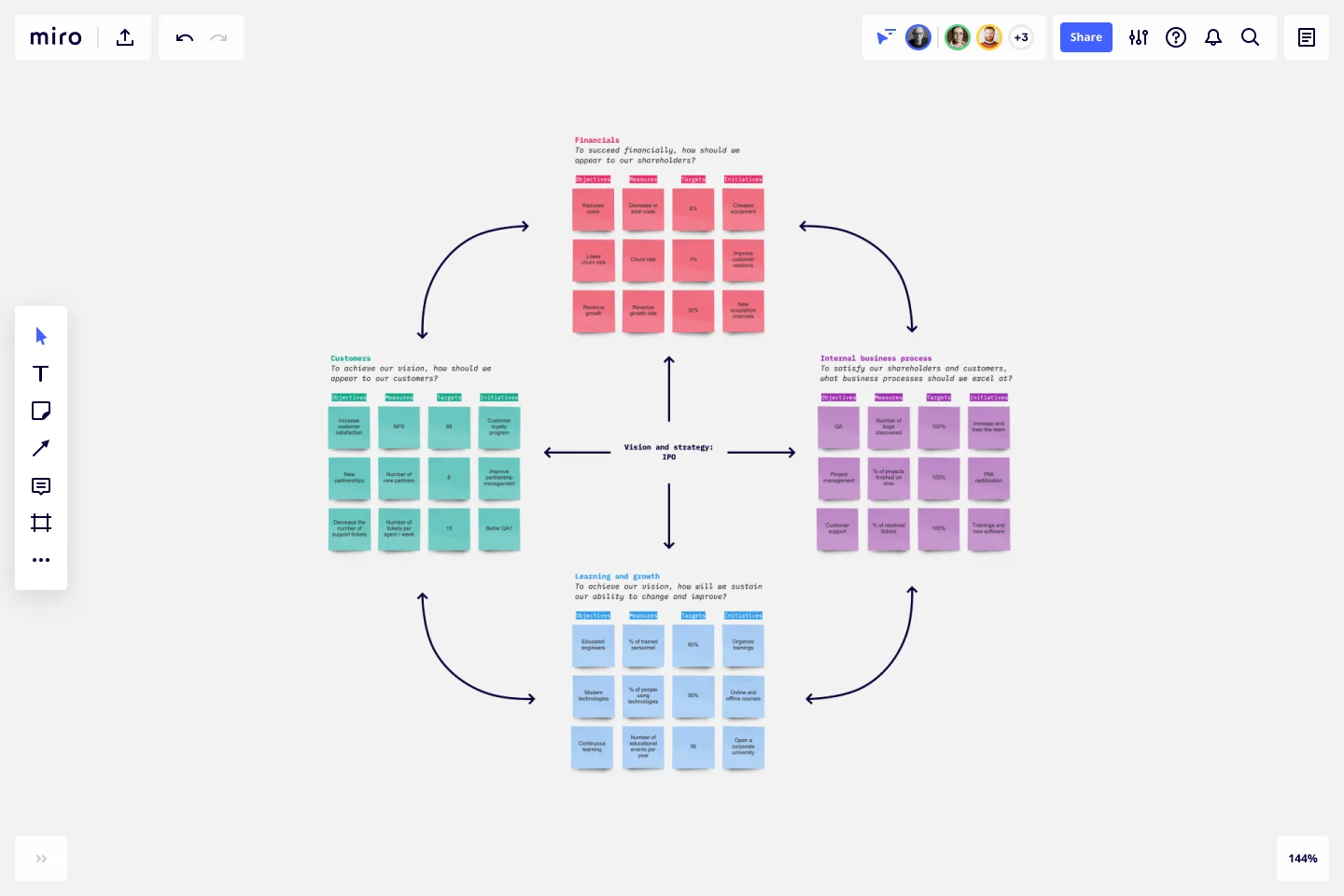
Structure: Four perspectives — Financial, Customer, Internal Process, Learning & Growth
Best for: Comprehensive performance measurement that goes beyond financial metrics
Creates strategy maps showing cause-effect relationships between different aspects of organizational performance. Ideal for established enterprises with mature processes.
Framework 4: Porter's Five Forces
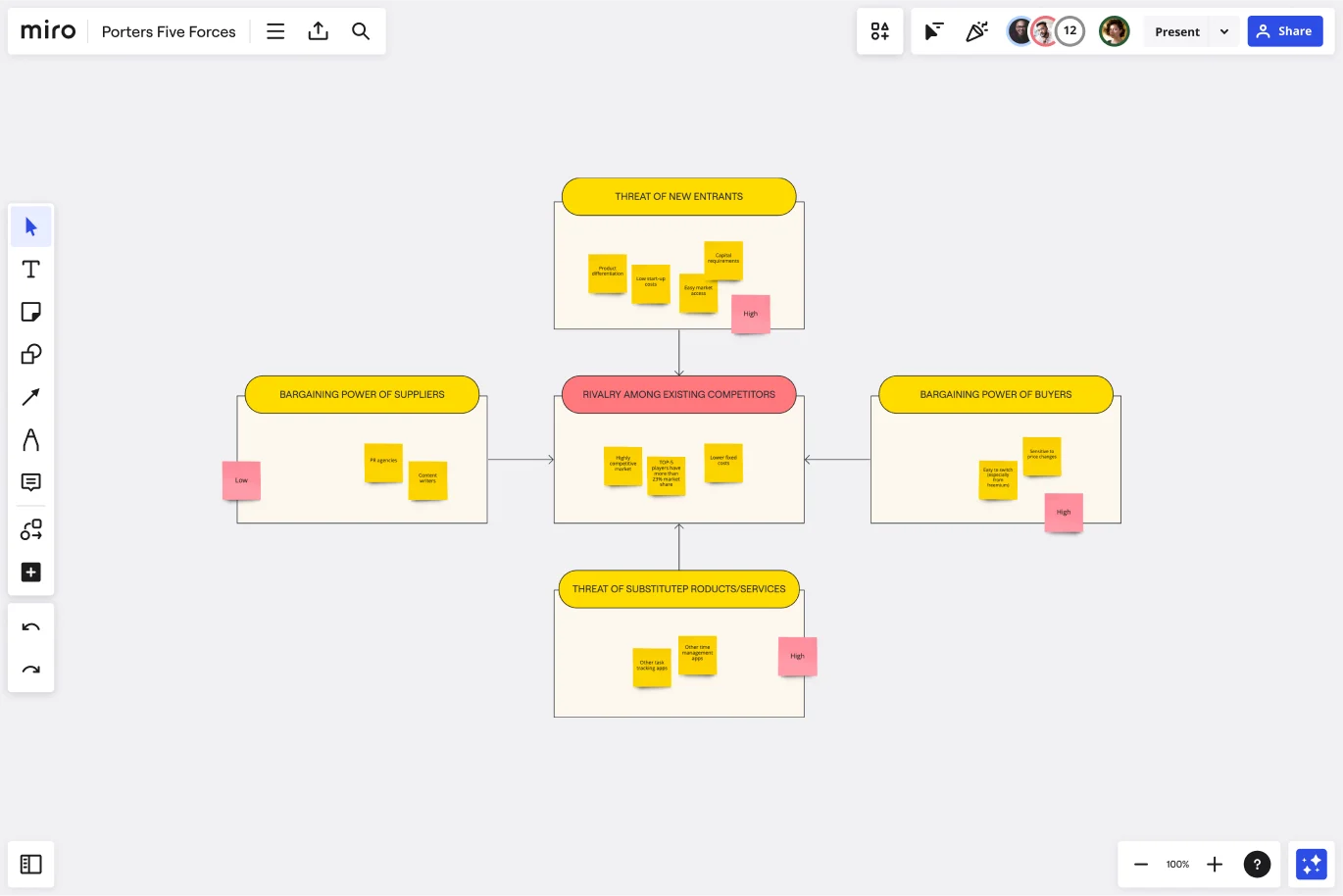
Structure: Analyzes competitive dynamics through five lenses — New Entrants, Supplier Power, Buyer Power, Substitutes, and Competitive Rivalry
Best for: Market entry decisions, competitive positioning, and understanding industry structure
Use case: When planning expansion into new markets or launching new products where competitive dynamics differ from your core business.
Framework 5: McKinsey 7S
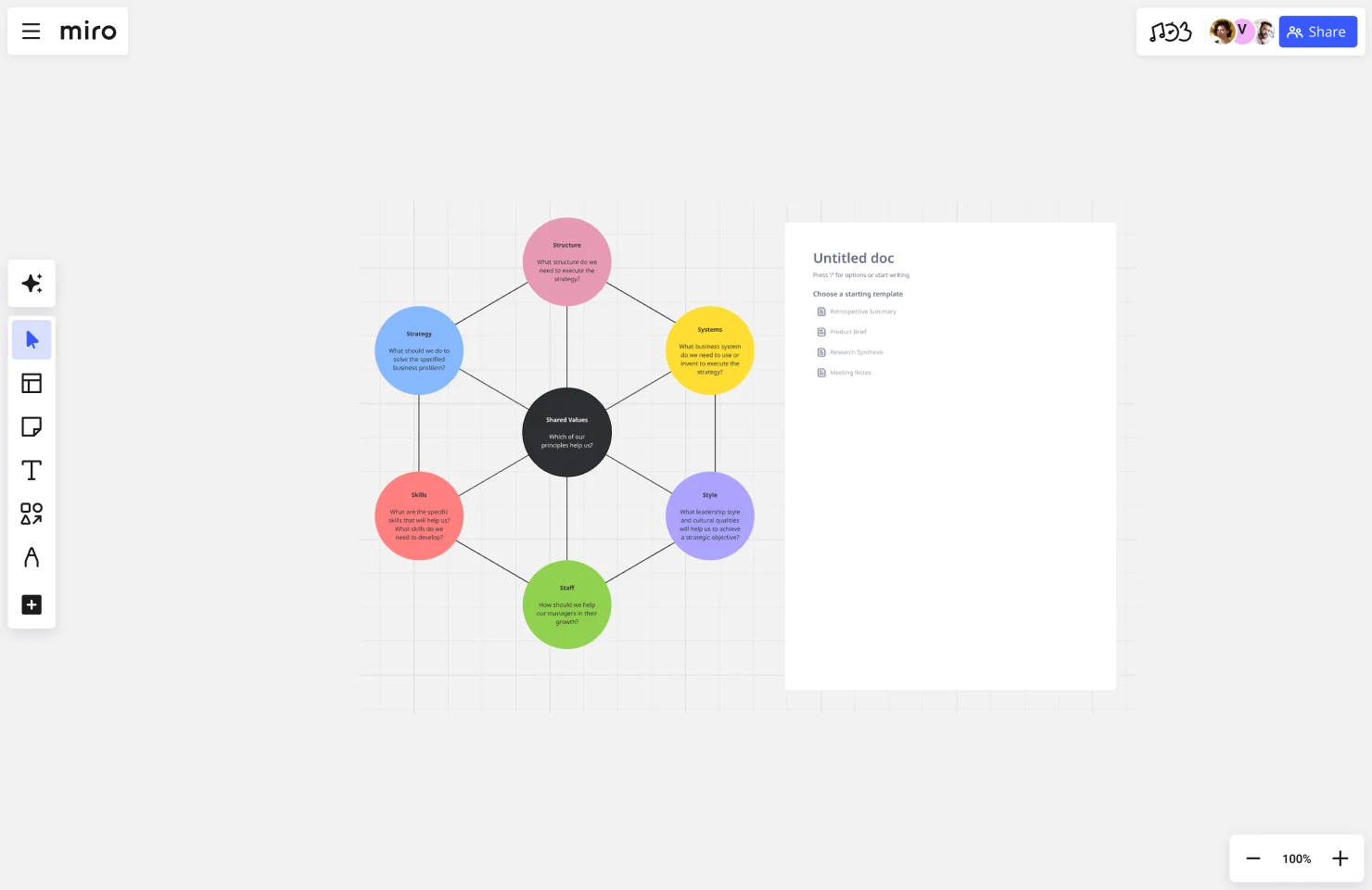
Structure: Seven interconnected elements — Strategy, Structure, Systems, Shared Values, Skills, Style, and Staff
Best for: Organizational change initiatives, merger integration, and ensuring alignment across all dimensions
This framework ensures you're not just changing strategy but also adjusting the supporting elements needed for successful execution.
Framework 6: Ansoff Growth Matrix
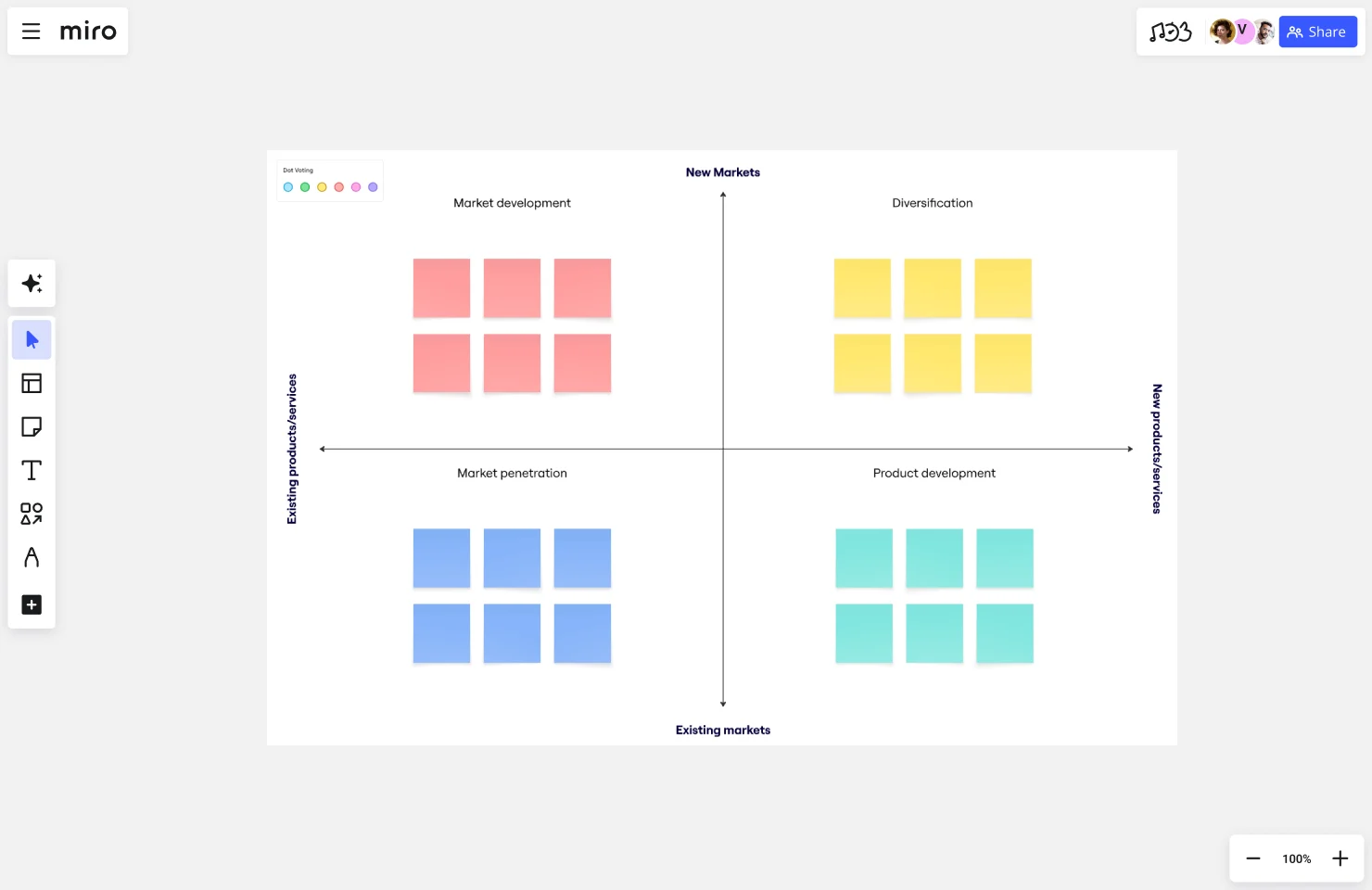
Structure: Four growth strategies mapped on a 2x2 grid — Market Penetration, Market Development, Product Development, and Diversification
Best for: Growth planning and risk assessment when choosing between different expansion paths
Risk mapping: Each quadrant represents increasing levels of risk, helping leadership make informed decisions about resource allocation.
Decision guide: When to use each framework
- Current state assessment → SWOT Analysis
- Goal setting & tracking → OKRs
- Performance management → Balanced Scorecard
- Market analysis → Porter's Five Forces
- Organizational change → McKinsey 7S
- Growth strategy → Ansoff Matrix
5 common organizational planning challenges (& solutions)
Challenge 1: Collaborative overload
The Problem: According to Harvard Business Review research, collaborative work has risen 50% or more over the past decade to consume 85% or more of most people's work weeks. Despite this dramatic increase in collaboration, companies still struggle to achieve their plans. Too many status meetings, endless email threads, and scattered tools create more friction than progress.
The Solution: Visual planning boards with asynchronous collaboration capabilities
Centralize planning in a shared workspace where teams can contribute on their own schedule. Replace status meetings with board updates that everyone can see. Organizations using this approach reduce communication overhead by 40%.
Challenge 2: Strategy-execution disconnect
The Problem: 90% of organizations fail to execute their strategies successfully. Goals feel abstract and disconnected from the daily work teams actually do.
The Solution: Visual goal cascading that creates clear line-of-sight from individual tasks to company strategy
Show how individual work connects to strategic objectives through visual links. Create transparency across all organizational levels so everyone understands the "why" behind their work.
"Miro allows all our teams to align themselves with certain tools and models: they work independently and create products that really meet our customers' needs," explains a product team lead.
Challenge 3: Plans becoming outdated
The Problem: Markets change faster than annual planning cycles. Rigid plans can't accommodate pivots when new information emerges.
The Solution: Agile planning methodology with living documents
Move away from static PDFs and PowerPoints toward living documents updated in real-time. Schedule quarterly strategic reviews with adjustment authority built into your governance process.
"Now that we have the Miro x Jira integration, we have reduced overhead time, and we've really increased the team's happiness as employees, and driving their ability to do their planning," shares a Prudential Agile team using integrated planning tools.
Challenge 4: Siloed department planning
The Problem: Each department plans independently, creating competing priorities and duplicated efforts.
The Solution: Cross-functional planning workshops
Include representatives from all key functions in your planning process. Use visual mapping to identify dependencies between teams. Implement democratic prioritization through voting and ranking exercises.
Challenge 5: Lack of execution visibility
The Problem: Leadership can't track progress toward strategic goals in real-time. Data is scattered across multiple tools.
The Solution: Integrated planning and execution dashboards
Create two-way sync between strategy boards and project management tools. Build real-time status visibility with clear accountability through RACI assignments.
How to choose the right organizational planning software
The right planning tool determines whether your plans drive results or collect dust. In 2026, organizational planning tools must support both strategic thinking (ideation, frameworks, workshops) and tactical execution (tasks, timelines, tracking).
The critical question: Does your team need visual collaboration for complex strategic planning, or structured task management for operational work?
Essential Miro features for strategic planning
1. Visual workspace for strategy mapping
Miro's infinite canvas supports comprehensive planning without space constraints. Teams need the ability to work with multiple frameworks — SWOT analyses, roadmaps, org charts, and customer journey maps — all in one connected space.
Why it matters: Traditional tools like Excel or standard productivity applications often lack the customization and ease of use needed for high-level strategic work. These tools force a trade-off between big-picture planning and tactical details.
Visual thinking helps teams see the big picture and make better decisions by spatially arranging ideas, showing relationships, and enabling everyone to literally be on the same page.
2. Real time collaboration
Simultaneous editing for distributed teams combined with asynchronous collaboration support (comments, @mentions, voting) eliminates version control nightmares. Everything exists in a single source of truth.
"With Miro we can map out strategy, design customer experiences, do team planning, and roadmap creation. What makes Miro effective is the ability to make the process easy to follow and inviting to participate," explains Anju Sharma, PM at HP.
3. Template library & frameworks
Pre-built templates for common planning activities enable teams to move from blank canvas to structured plan in minutes. Look for customizable options that match your specific processes.
4. Integration ecosystem
Connect with project management tools (Jira, Asana, Azure DevOps), communication platforms (Slack, Teams, Zoom), and other business systems. The best planning tools serve as the central hub that connects to your existing workflow.
5. Presentation & reporting
Transform planning boards into executive presentations without rebuilding content in PowerPoint. Live presentation mode for stakeholder meetings plus export options make strategy accessible to the entire organization.
Visual planning vs. task management: What's right for you?
Decision Framework:
Choose visual planning tools if you:
- Run strategic planning workshops regularly
- Need cross-functional alignment and consensus-building
- Work with complex systems requiring visualization
- Present plans to executive stakeholders frequently
- Value creative problem-solving and ideation
Choose task management tools if you:
- Focus primarily on operational execution
Need sophist
icated task dependencies and automation
- Manage delivery timelines and sprint planning
- Have straightforward workflows without much strategic planning
The hybrid approach: Many organizations use visual tools for strategy and planning, integrated with task tools for execution. This provides the best of both worlds — strategic clarity plus operational precision.
8 Organizational planning best practices for 2026
1. Start planning early
Begin 3-4 months before the year or quarter starts. Allow time for stakeholder input, iteration, and buy-in. Rushed planning produces poor results that teams don't believe in.
2. Include cross-functional voices
Running a collaborative roadmapping workshop with relevant employees can be an option to engage everyone, leverage diverse perspectives, and stimulate open discussion. Democratic prioritization builds commitment to execution.
3. Balance vision with agility
Maintain a 3-5 year strategic vision, but plan tactically in quarters not years. Review and adjust quarterly based on market changes and learnings. Long-term direction with short-term flexibility.
4. Make plans visual and accessible
Move beyond dense documents. Visual plans are easier to understand, remember, and reference. Make them accessible to the entire organization, not locked in leadership files.
5. Connect strategy to daily work
Help team members see how their work contributes to company goals. Your plan has no value if it's poorly understood across the organization, preventing you from achieving alignment and support.
6. Use data to inform decisions
Ground planning in customer feedback, market research, competitive intelligence, and internal performance data. Avoid planning based solely on opinions or assumptions.
7. Build feedback loops
Establish regular check-ins (weekly team, monthly initiative, quarterly strategic). Create safe spaces for teams to share blockers and challenges. Iterate based on learnings rather than treating the plan as set in stone.
8. Use AI and automation for efficiency
AI tools can help generate initial frameworks, synthesize customer feedback, identify patterns in data, and automate routine planning tasks. This frees human time for strategic thinking and decision-making.
"With Miro I've successfully reduced the number of meetings in my day. Using Talktrack, I'm able to convey nuances to teammates asynchronously so we can still communicate effectively," Kimura Kayo, change practitioner at Fujitsu.
Transform Your Organizational Planning in 2026
Organizational planning is the bridge between vision and results. Effective planning requires understanding the 4 types of planning (strategic, tactical, operational, contingency), following a proven 7-step process from vision to execution, using the right frameworks like SWOT and OKRs, and choosing tools that support both strategy and execution.
The competitive advantage goes to organizations that master visual organizational planning — they reduce time-to-market by up to 70% while maintaining strategic alignment across distributed teams.
The most successful organizations in 2026 won't treat planning as an annual event. They'll build it into their culture through continuous collaboration, visual thinking, and adaptive frameworks that evolve as quickly as their markets do.
Ready to transform your organizational planning?
Get Free Strategic Planning Templates →
Explore how teams use visual collaboration to connect strategy with execution, run more effective planning workshops, and keep everyone aligned on what matters most.
Author: Miro Team
Last update: November 17, 2025